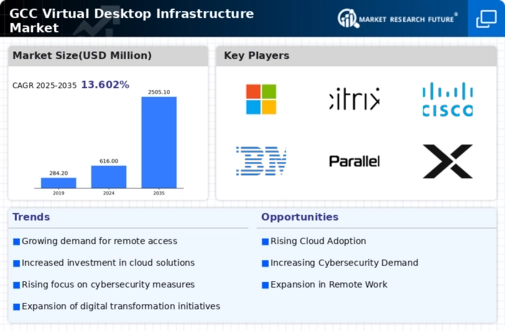The virtual desktop-infrastructure market is currently characterized by a dynamic competitive landscape, driven by the increasing demand for remote work solutions and the need for enhanced data security. Key players such as VMware (US), Citrix Systems (US), and Microsoft (US) are at the forefront, each adopting distinct strategies to solidify their market positions. VMware (US) focuses on innovation through its cloud-based solutions, while Citrix Systems (US) emphasizes partnerships to enhance its service offerings. Microsoft (US) leverages its extensive ecosystem to integrate virtual desktop solutions with its existing cloud services, thereby creating a seamless user experience. Collectively, these strategies contribute to a competitive environment that is both collaborative and competitive, as companies seek to differentiate themselves through technological advancements and customer-centric solutions.
In terms of business tactics, companies are increasingly localizing their operations to better serve regional markets, optimizing supply chains to enhance efficiency, and investing in digital transformation initiatives. The market structure appears moderately fragmented, with several key players holding substantial market shares while also facing competition from emerging firms. This fragmentation allows for a diverse range of offerings, catering to various customer needs and preferences, which in turn influences pricing strategies and service delivery.
In October 2025, VMware (US) announced a strategic partnership with a leading cybersecurity firm to enhance the security features of its virtual desktop solutions. This move is significant as it addresses growing concerns regarding data breaches and cyber threats, positioning VMware (US) as a leader in secure virtual desktop offerings. The partnership is expected to bolster customer confidence and expand VMware's market reach, particularly among enterprises prioritizing security in their IT infrastructure.
In September 2025, Citrix Systems (US) launched a new version of its virtual desktop service, incorporating advanced AI capabilities to optimize user experience and resource allocation. This development is crucial as it reflects the increasing integration of AI technologies in virtual desktop solutions, potentially improving operational efficiency and user satisfaction. Citrix's focus on AI-driven enhancements may provide a competitive edge, appealing to organizations looking to leverage technology for improved productivity.
In August 2025, Microsoft (US) expanded its Azure Virtual Desktop offerings by introducing new features aimed at enhancing scalability and performance. This expansion is indicative of Microsoft's commitment to maintaining its leadership position in the market, as it seeks to provide comprehensive solutions that cater to the evolving needs of businesses. By continuously enhancing its offerings, Microsoft (US) is likely to attract a broader customer base, further solidifying its market presence.
As of November 2025, current trends in the virtual desktop-infrastructure market include a strong emphasis on digitalization, sustainability, and the integration of AI technologies. Strategic alliances are increasingly shaping the competitive landscape, as companies recognize the value of collaboration in driving innovation and expanding market reach. Looking ahead, competitive differentiation is expected to evolve, with a shift from price-based competition to a focus on innovation, technological advancements, and supply chain reliability. This transition may redefine how companies position themselves in the market, ultimately leading to a more sustainable and resilient virtual desktop-infrastructure ecosystem.

















Leave a Comment